Abstract
Bacteria from members of the families Enterobacteriaceae and Pseudomonadaceae were grown under phosphate-deficient (0.1 to 0.2 mM Pi) conditions and examined for the production of novel membrane proteins. Of the 17 strains examined, 12 expressed a phosphate-starvation-induced outer membrane protein which was heat modifiable in that after solubilization in sodium dodecyl sulfate at low temperature the protein ran on gels as a diffuse band of higher apparent molecular weight, presumably an oligomer form, which shifted to an apparent monomer form after solubilization at high temperature. These proteins fell into two classes based on their monomer molecular weights and the detergent conditions required to release the proteins from the peptidoglycan. The first class, expressed by species of the Pseudomonas fluorescens branch of the family Pseudomonadaceae, was similar to the phosphate-starvation-inducible, channel-forming protein P of Pseudomonas aeruginosa. The second class resembled the major enterobacterial porin proteins and the phosphate-regulated PhoE protein of Escherichia coli. Using a protein P-trimer-specific polyclonal antiserum, we were able to demonstrate cross-reactivity of the oligomeric forms of both classes of these proteins on Western blots. However, this antiserum did not react with the monomeric forms of any of these proteins, including protein P monomers. With a protein P-monomer-specific antiserum, no reactivity was seen with any of the phosphate-starvation-inducible membrane proteins (in either oligomeric or monomeric form), with the exception of protein P monomers. These results suggest the presence of conserved antigenic determinants only in the native, functional proteins.
Full text
PDF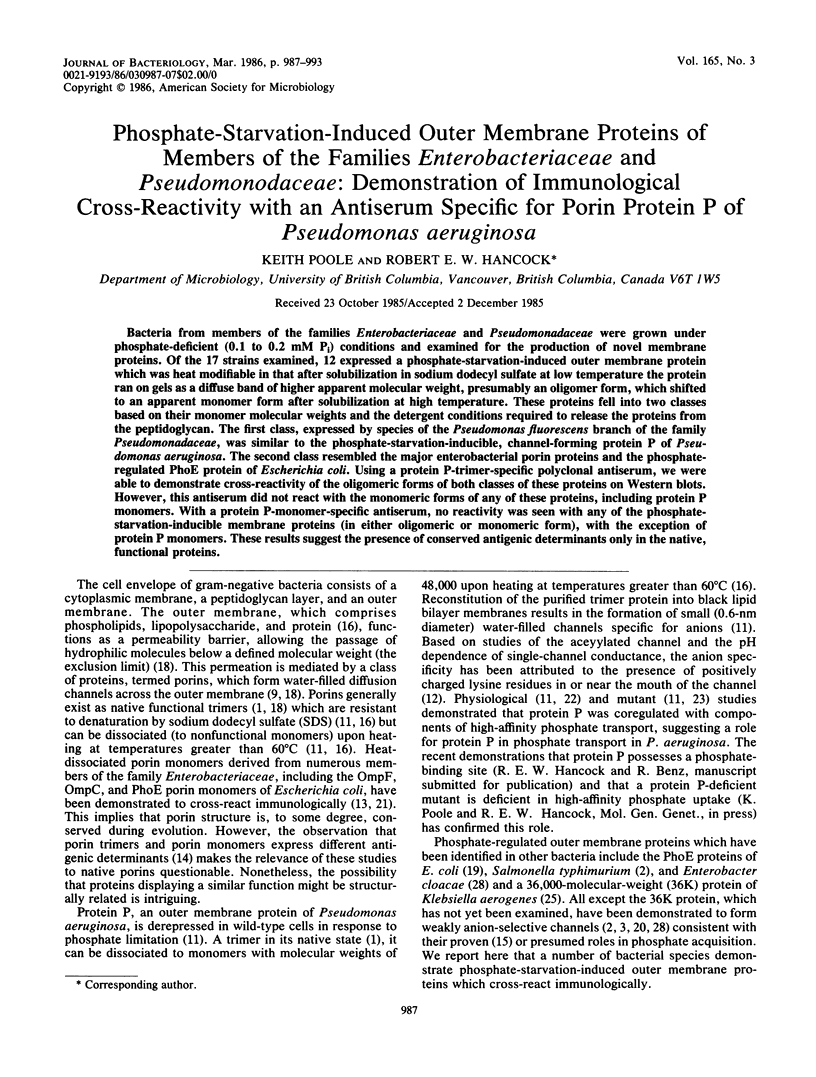
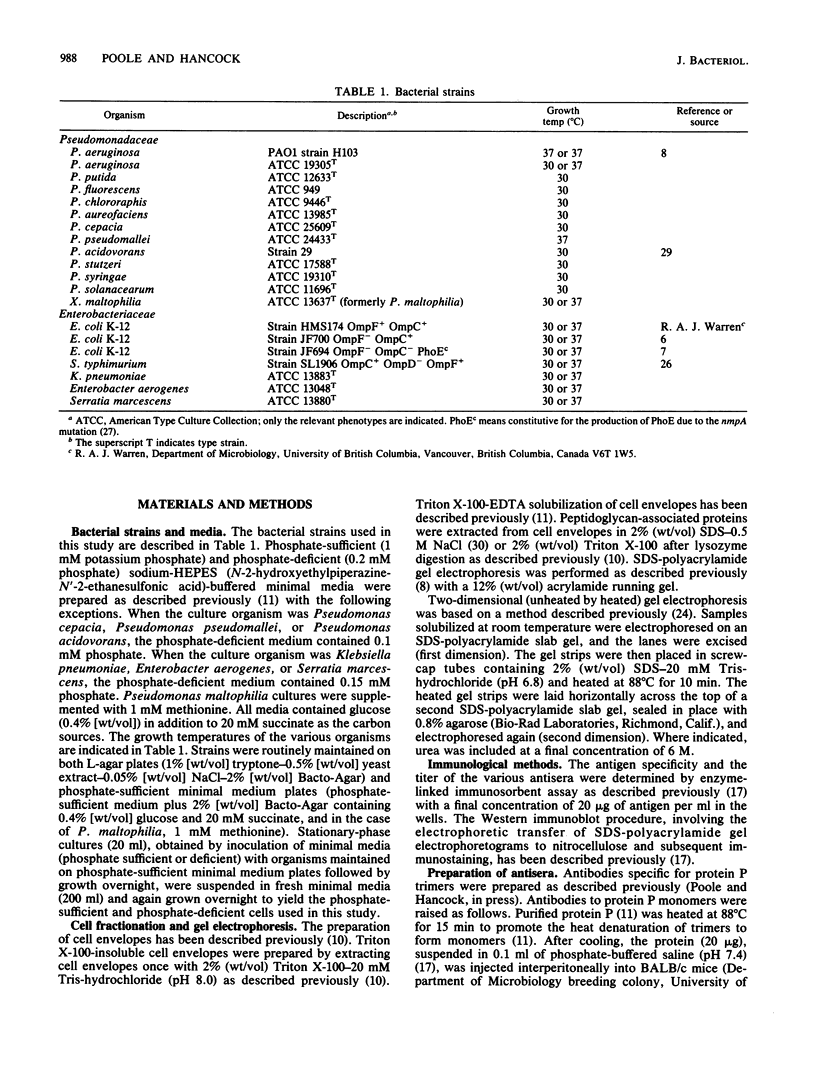

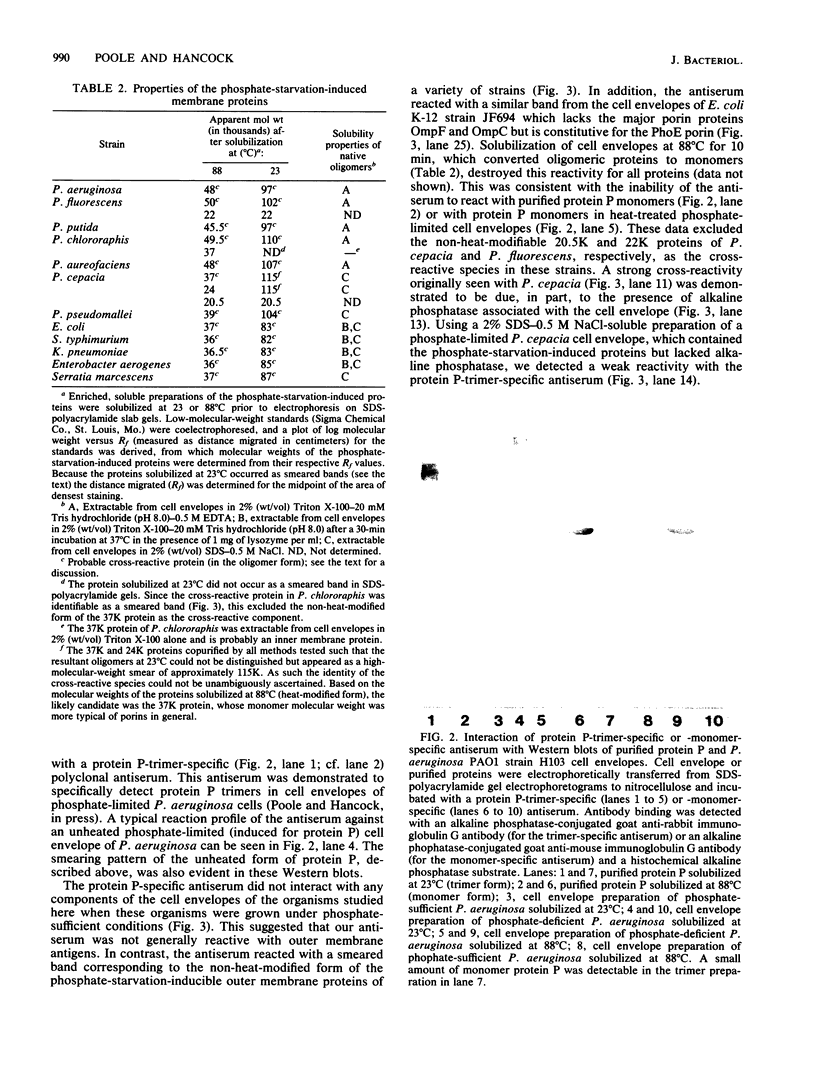
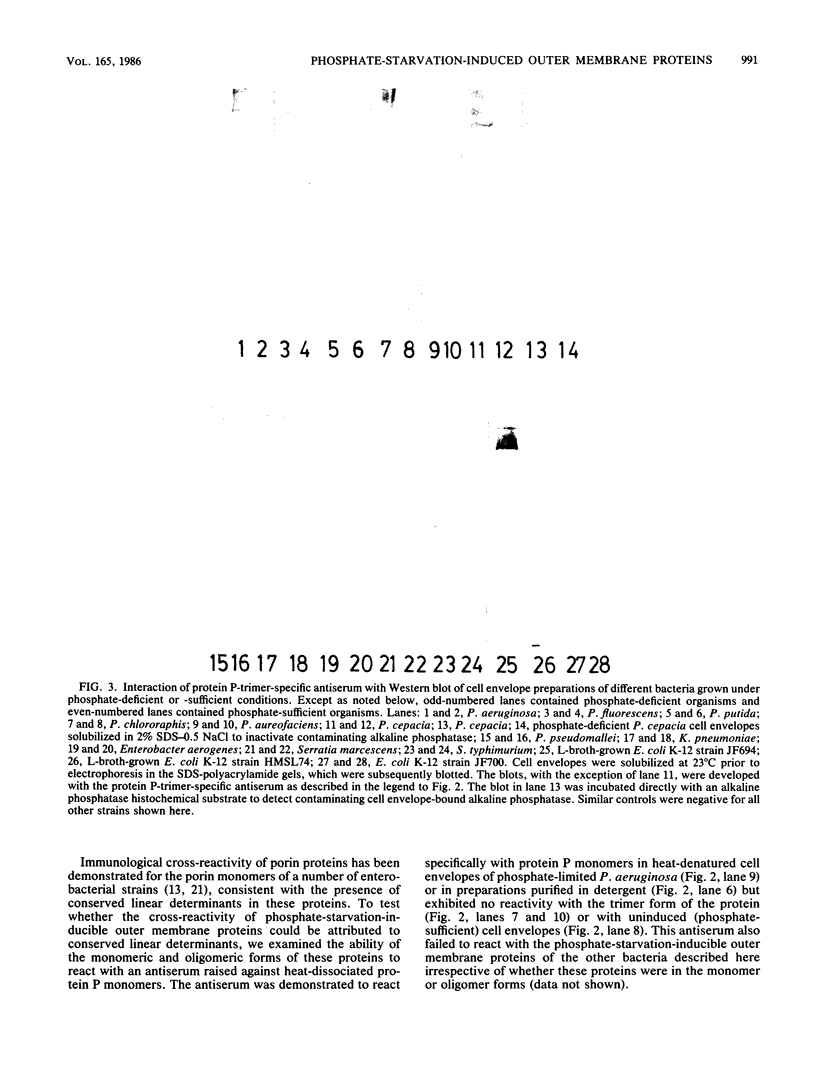
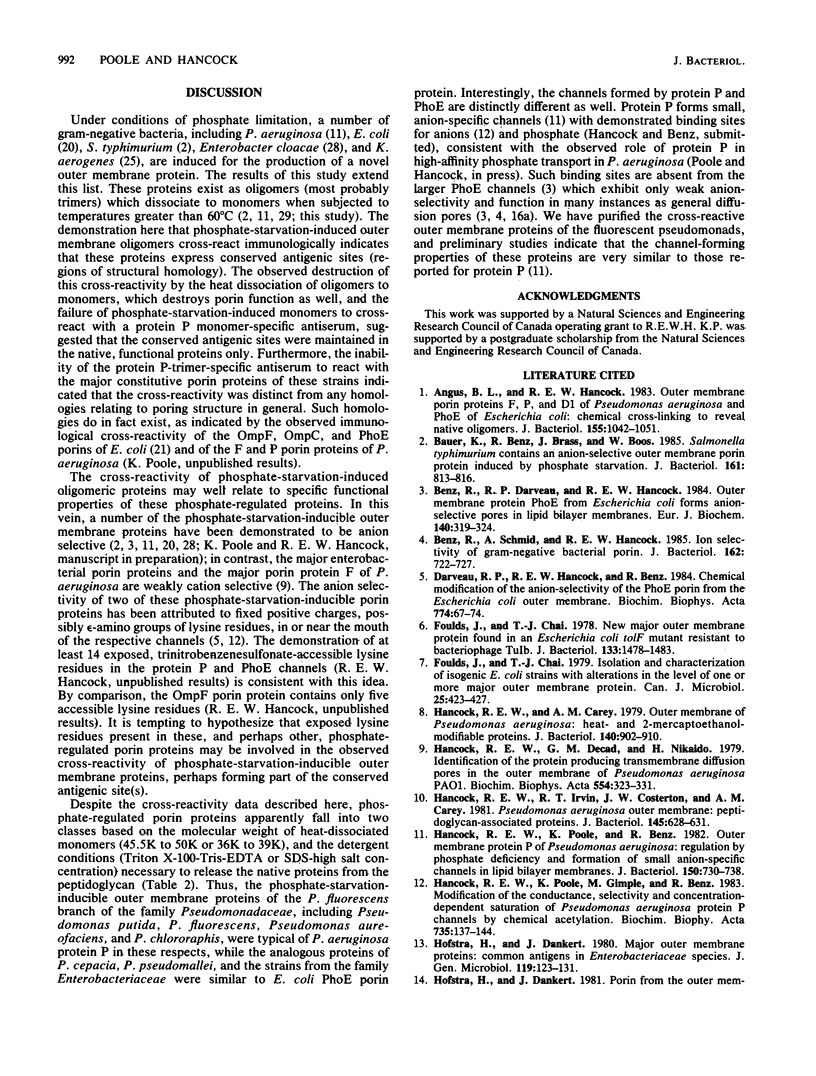

Images in this article
Selected References
These references are in PubMed. This may not be the complete list of references from this article.
- Angus B. L., Hancock R. E. Outer membrane porin proteins F, P, and D1 of Pseudomonas aeruginosa and PhoE of Escherichia coli: chemical cross-linking to reveal native oligomers. J Bacteriol. 1983 Sep;155(3):1042–1051. doi: 10.1128/jb.155.3.1042-1051.1983. [DOI] [PMC free article] [PubMed] [Google Scholar]
- Bauer K., Benz R., Brass J., Boos W. Salmonella typhimurium contains an anion-selective outer membrane porin induced by phosphate starvation. J Bacteriol. 1985 Feb;161(2):813–816. doi: 10.1128/jb.161.2.813-816.1985. [DOI] [PMC free article] [PubMed] [Google Scholar]
- Benz R., Darveau R. P., Hancock R. E. Outer-membrane protein PhoE from Escherichia coli forms anion-selective pores in lipid-bilayer membranes. Eur J Biochem. 1984 Apr 16;140(2):319–324. doi: 10.1111/j.1432-1033.1984.tb08104.x. [DOI] [PubMed] [Google Scholar]
- Benz R., Schmid A., Hancock R. E. Ion selectivity of gram-negative bacterial porins. J Bacteriol. 1985 May;162(2):722–727. doi: 10.1128/jb.162.2.722-727.1985. [DOI] [PMC free article] [PubMed] [Google Scholar]
- Darveau R. P., Hancock R. E., Benz R. Chemical modification of the anion selectivity of the PhoE porin from the Escherichia coli outer membrane. Biochim Biophys Acta. 1984 Jul 11;774(1):67–74. doi: 10.1016/0005-2736(84)90275-x. [DOI] [PubMed] [Google Scholar]
- Foulds J., Chai T. J. New major outer membrane proteins found in an Escherichia coli tolF mutant resistant to bacteriophage TuIb. J Bacteriol. 1978 Mar;133(3):1478–1483. doi: 10.1128/jb.133.3.1478-1483.1978. [DOI] [PMC free article] [PubMed] [Google Scholar]
- Foulds J., Chai T. Isolation and characterization of isogenic E. coli strains with alterations in the level of one or more major outer membrane proteins. Can J Microbiol. 1979 Mar;25(3):423–427. doi: 10.1139/m79-065. [DOI] [PubMed] [Google Scholar]
- Hancock R. E., Carey A. M. Outer membrane of Pseudomonas aeruginosa: heat- 2-mercaptoethanol-modifiable proteins. J Bacteriol. 1979 Dec;140(3):902–910. doi: 10.1128/jb.140.3.902-910.1979. [DOI] [PMC free article] [PubMed] [Google Scholar]
- Hancock R. E., Decad G. M., Nikaido H. Identification of the protein producing transmembrane diffusion pores in the outer membrane of Pseudomonas aeruginosa PA01. Biochim Biophys Acta. 1979 Jul 5;554(2):323–331. doi: 10.1016/0005-2736(79)90373-0. [DOI] [PubMed] [Google Scholar]
- Hancock R. E., Irvin R. T., Costerton J. W., Carey A. M. Pseudomonas aeruginosa outer membrane: peptidoglycan-associated proteins. J Bacteriol. 1981 Jan;145(1):628–631. doi: 10.1128/jb.145.1.628-631.1981. [DOI] [PMC free article] [PubMed] [Google Scholar]
- Hancock R. E., Poole K., Benz R. Outer membrane protein P of Pseudomonas aeruginosa: regulation by phosphate deficiency and formation of small anion-specific channels in lipid bilayer membranes. J Bacteriol. 1982 May;150(2):730–738. doi: 10.1128/jb.150.2.730-738.1982. [DOI] [PMC free article] [PubMed] [Google Scholar]
- Hancock R. E., Poole K., Gimple M., Benz R. Modification of the conductance, selectivity and concentration-dependent saturation of Pseudomonas aeruginosa protein P channels by chemical acetylation. Biochim Biophys Acta. 1983 Oct 26;735(1):137–144. doi: 10.1016/0005-2736(83)90269-9. [DOI] [PubMed] [Google Scholar]
- Hofstra H., Dankert J. Major outer membrane proteins: common antigens in enterobacteriaceae species. J Gen Microbiol. 1980 Jul;119(1):123–131. doi: 10.1099/00221287-119-1-123. [DOI] [PubMed] [Google Scholar]
- Hofstra H., Dankert J. Porin from the outer membrane of Escherichia coli: immunological characterization of native and heat-dissociated forms. J Gen Microbiol. 1981 Aug;125(2):285–292. doi: 10.1099/00221287-125-2-285. [DOI] [PubMed] [Google Scholar]
- Korteland J., Tommassen J., Lugtenberg B. PhoE protein pore of the outer membrane of Escherichia coli K12 is a particularly efficient channel for organic and inorganic phosphate. Biochim Biophys Acta. 1982 Sep 9;690(2):282–289. doi: 10.1016/0005-2736(82)90332-7. [DOI] [PubMed] [Google Scholar]
- Lugtenberg B., Van Alphen L. Molecular architecture and functioning of the outer membrane of Escherichia coli and other gram-negative bacteria. Biochim Biophys Acta. 1983 Mar 21;737(1):51–115. doi: 10.1016/0304-4157(83)90014-x. [DOI] [PubMed] [Google Scholar]
- Lugtenberg B., van Boxtel R., Verhoef C., van Alphen W. Pore protein e of the outer membrane of Escherichia coli K12. FEBS Lett. 1978 Dec 1;96(1):99–105. doi: 10.1016/0014-5793(78)81071-0. [DOI] [PubMed] [Google Scholar]
- Mutharia L. M., Hancock R. E. Surface localization of Pseudomonas aeruginosa outer membrane porin protein F by using monoclonal antibodies. Infect Immun. 1983 Dec;42(3):1027–1033. doi: 10.1128/iai.42.3.1027-1033.1983. [DOI] [PMC free article] [PubMed] [Google Scholar]
- Overbeeke N., Lugtenberg B. Expression of outer membrane protein e of Escherichia coli K12 by phosphate limitation. FEBS Lett. 1980 Apr 7;112(2):229–232. doi: 10.1016/0014-5793(80)80186-4. [DOI] [PubMed] [Google Scholar]
- Overbeeke N., Lugtenberg B. Recognition site for phosphorus-containing compounds and other negatively charged solutes on the PhoE protein pore of the outer membrane of Escherichia coli K12. Eur J Biochem. 1982 Aug;126(1):113–118. doi: 10.1111/j.1432-1033.1982.tb06754.x. [DOI] [PubMed] [Google Scholar]
- Overbeeke N., Van Scharrenburg G., Lugtenberg B. Antigenic relationships between pore proteins of Escherichia coli K12. Eur J Biochem. 1980 Sep;110(1):247–254. doi: 10.1111/j.1432-1033.1980.tb04862.x. [DOI] [PubMed] [Google Scholar]
- Poole K., Hancock R. E. Phosphate transport in Pseudomonas aeruginosa. Involvement of a periplasmic phosphate-binding protein. Eur J Biochem. 1984 Nov 2;144(3):607–612. doi: 10.1111/j.1432-1033.1984.tb08508.x. [DOI] [PubMed] [Google Scholar]
- Russell R. R. Two-dimensional SDS-polyacrylamide gel electrophoresis of heat-modifiable outer-membrane proteins. Can J Microbiol. 1976 Jan;22(1):83–91. doi: 10.1139/m76-011. [DOI] [PubMed] [Google Scholar]
- Sterkenburg A., Vlegels E., Wouters J. T. Influence of nutrient limitation and growth rate on the outer membrane proteins of Klebsiella aerogenes NCTC 418. J Gen Microbiol. 1984 Sep;130(9):2347–2355. doi: 10.1099/00221287-130-9-2347. [DOI] [PubMed] [Google Scholar]
- Stocker B. A., Nurminen M., Mäkelä P. H. Mutants defective in the 33K outer membrane protein of Salmonella typhimurium. J Bacteriol. 1979 Aug;139(2):376–383. doi: 10.1128/jb.139.2.376-383.1979. [DOI] [PMC free article] [PubMed] [Google Scholar]
- Tokunaga M., Tokunaga H., Okajima Y., Nakae T. Characterization of porins from the outer membrane of Salmonella typhimurium. 2. Physical properties of the functional oligomeric aggregates. Eur J Biochem. 1979 Apr;95(3):441–448. doi: 10.1111/j.1432-1033.1979.tb12983.x. [DOI] [PubMed] [Google Scholar]
- Verhoef C., van Koppen C., Overduin P., Lugtenberg B., Korteland J., Tommassen J. Cloning and expression in Escherichia coli K-12 of the structural gene for outer membrane PhoE protein from Enterobacter cloacae. Gene. 1984 Dec;32(1-2):107–115. doi: 10.1016/0378-1119(84)90038-6. [DOI] [PubMed] [Google Scholar]
- Warren R. A. Amber suppressor mutations in Pseudomonas acidovorans. J Bacteriol. 1979 Feb;137(2):1053–1055. doi: 10.1128/jb.137.2.1053-1055.1979. [DOI] [PMC free article] [PubMed] [Google Scholar]
- Yoshimura F., Zalman L. S., Nikaido H. Purification and properties of Pseudomonas aeruginosa porin. J Biol Chem. 1983 Feb 25;258(4):2308–2314. [PubMed] [Google Scholar]





